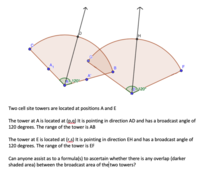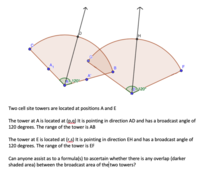You are using an out of date browser. It may not display this or other websites correctly.
You should upgrade or use an alternative browser.
You should upgrade or use an alternative browser.
Help regarding overlapping areas
- Thread starter c0unse1
- Start date
yoscar04
Full Member
- Joined
- Jun 3, 2020
- Messages
- 274
By the way I recommend you to read the forum guidelines.
Welcome to our tutoring boards! This page summarizes some main points from our posting guidelines.
This page summarizes some main points from our posting guidelines.
As our name implies, we provide math help (primarily to students with homework). We do not generally post immediate answers or step-by-step solutions. We prefer to help by having a conversation, just like tutoring! Please begin the conversation, by telling us about your situation. The more detail you provide, the better our responses will be.
NOTE 1: If you've learned about Order of Operations, then be sure to type grouping symbols in your posts where needed, to prevent confusion.
For example, typing x+80/x-10 means x+80x−10x+80x−10
But typing (x+80)/(x-10) means x+80x−10x+80x−10
NOTE 2: The first few posts from each new member will not appear on the boards until after they've been approved by a moderator.
Here's what you need to do, to get good help more quickly:
1. From where does your question come?
It really helps to know why you're working on math or what math course you're taking. There are many ways to find the same answers. We'd like to discuss the method that you're learning and to explain at your level of study.
"I'm in seventh grade. We're doing algebra tiles"
"I just started college calculus, and we're reviewing limits."
"I need help understanding a formula on my bank's website."
"Doing high school geometry -- here's a picture of how far I got."
"Practicing for my trig final; I don't understand this example."
"I'm an older student reviewing for a placement test; please check my work."
2. Post the exercise or your question completely and accurately. Start a new thread for each exercise.
The easiest way is to copy exercises word-for-word (including the instructions). PLEASE use the Preview button, to check your post before submitting it. Students waste their time, when they submit posts containing typographical math errors or unreadable images.
3. Show work that you've already done (even if you think it's wrong), and try to explain why you're stuck.
Simply posting an exercise statement without showing work or asking specific questions is not enough for us to help you quickly. As tutors, we need clues about parts you already understand versus what you find confusing, so we can determine where to begin helping you. The sooner you show efforts, the sooner we can get to the heart of the matter. If you cannot begin an exercise, please tell us why (eg: unknown concept, confusing example, unfamiliar symbol, missing definition, unclear language).
4. We may respond by asking you questions (if we think something is missing or unclear).
Please respond to our questions; this saves you time. If you're not sure how to answer, say so. When people skip our questions, we might think they're not paying attention or need a face-to-face tutor, instead.
? If there's anything in a reply that you don't understand, let us know what it is, and we'll try that part again.
Welcome to our tutoring boards!
As our name implies, we provide math help (primarily to students with homework). We do not generally post immediate answers or step-by-step solutions. We prefer to help by having a conversation, just like tutoring! Please begin the conversation, by telling us about your situation. The more detail you provide, the better our responses will be.
NOTE 1: If you've learned about Order of Operations, then be sure to type grouping symbols in your posts where needed, to prevent confusion.
For example, typing x+80/x-10 means x+80x−10x+80x−10
But typing (x+80)/(x-10) means x+80x−10x+80x−10
NOTE 2: The first few posts from each new member will not appear on the boards until after they've been approved by a moderator.
Here's what you need to do, to get good help more quickly:
1. From where does your question come?
It really helps to know why you're working on math or what math course you're taking. There are many ways to find the same answers. We'd like to discuss the method that you're learning and to explain at your level of study.
"I'm in seventh grade. We're doing algebra tiles"
"I just started college calculus, and we're reviewing limits."
"I need help understanding a formula on my bank's website."
"Doing high school geometry -- here's a picture of how far I got."
"Practicing for my trig final; I don't understand this example."
"I'm an older student reviewing for a placement test; please check my work."
2. Post the exercise or your question completely and accurately. Start a new thread for each exercise.
The easiest way is to copy exercises word-for-word (including the instructions). PLEASE use the Preview button, to check your post before submitting it. Students waste their time, when they submit posts containing typographical math errors or unreadable images.
3. Show work that you've already done (even if you think it's wrong), and try to explain why you're stuck.
Simply posting an exercise statement without showing work or asking specific questions is not enough for us to help you quickly. As tutors, we need clues about parts you already understand versus what you find confusing, so we can determine where to begin helping you. The sooner you show efforts, the sooner we can get to the heart of the matter. If you cannot begin an exercise, please tell us why (eg: unknown concept, confusing example, unfamiliar symbol, missing definition, unclear language).
4. We may respond by asking you questions (if we think something is missing or unclear).
Please respond to our questions; this saves you time. If you're not sure how to answer, say so. When people skip our questions, we might think they're not paying attention or need a face-to-face tutor, instead.
? If there's anything in a reply that you don't understand, let us know what it is, and we'll try that part again.
Dr.Peterson
Elite Member
- Joined
- Nov 12, 2017
- Messages
- 16,605
It would be helpful to know, for example, whether this is something you want to program in a computer, or to do humanly; and how much you know about trigonometry and vectors. This is part of the reason for asking to see what you have tried. (If I were going to do this to check a particular site, I'd probably draw it up in GeoGebra as you have done, and just look. And the locations could be entered as variables so you could easily check this for one plan after another by just typing in data.)
I think you need to do a (possibly long) series of tests, perhaps checking the easiest things first. You might, for example, first check whether any of the corners of one sector are inside the other. If not, they could still overlap, but only in certain ways, which you could check one at a time (for instance, the arcs might intersect, or an arc might intersect a line).
Rather than expect someone here to write the whole thing for you, I'd rather you did what you could, and then asked for a formula for a specific part, such as an arc intersecting a line.
It will also be helpful if you specify the actual input to be used, particularly for the direction. Will you be given the location of D (which gives both direction and range), or an angle from north, or a vector, or what?
Thank you for your patience.
yes, this is something I would like to program into a computer. I have reasonable maths knowledge , A level albeit 30 years ago.
i have a database containing many thousands of ‘paired’ cell sites. I wish to know in relation to any given pair, whether they might have the potential for overlap, or not.
in relation to each cell site I have it’s location (in eastings and northings - which equate to 1m each) and the azimuth the cell site is pointing from the vertical. Each cell site ‘broadcasts’ in an arc, +/-60 degrees from the direction its pointed.
each cell site has a range of approximately 2km, but this would best be expressed as a variable due to different ranges for urban and rural areas.
i can work out using Pythagorus whether the cell masts are too far away to provide overlap ie if >4km then cannot have overlap.
i had the thought that I need to work out firstly the point of intersection between the AB and EG in my example above, and then see if that is <2km from both A and E. I have no idea how to go about this.
yes, this is something I would like to program into a computer. I have reasonable maths knowledge , A level albeit 30 years ago.
i have a database containing many thousands of ‘paired’ cell sites. I wish to know in relation to any given pair, whether they might have the potential for overlap, or not.
in relation to each cell site I have it’s location (in eastings and northings - which equate to 1m each) and the azimuth the cell site is pointing from the vertical. Each cell site ‘broadcasts’ in an arc, +/-60 degrees from the direction its pointed.
each cell site has a range of approximately 2km, but this would best be expressed as a variable due to different ranges for urban and rural areas.
i can work out using Pythagorus whether the cell masts are too far away to provide overlap ie if >4km then cannot have overlap.
i had the thought that I need to work out firstly the point of intersection between the AB and EG in my example above, and then see if that is <2km from both A and E. I have no idea how to go about this.
Dr.Peterson
Elite Member
- Joined
- Nov 12, 2017
- Messages
- 16,605
That's a good piece to ask about. Probably the most straightforward approach would be to write an equation for each line using point-slope, getting the slope from the direction (tangent of the azimuth plus or minus 60 degrees). Then just solve those two equations.i can work out using Pythagorus whether the cell masts are too far away to provide overlap ie if >4km then cannot have overlap.
i had the thought that I need to work out firstly the point of intersection between the AB and EG in my example above, and then see if that is <2km from both A and E. I have no idea how to go about this.
D
Deleted member 4993
Guest
yoscar04
Full Member
- Joined
- Jun 3, 2020
- Messages
- 274
It looks like we will need another input besides the angles CAB, GEF and the coordinates of the points A and E. Note that we could rotate the circular sector on the right hand side keeping the angle GEF and the coordinates of E, and that would lead to a different overlap.
D
Deleted member 4993
Guest
What is vertical here - pointing NORTH?I also have the angle from the vertical to AD, and the vertical to EH
yoscar04
Full Member
- Joined
- Jun 3, 2020
- Messages
- 274
Of course, I didn't mean an specific number but if it is an input of your problem. Have you tried using analytic geometry, write the different objects (circular sectors and straight lines) in terms of Cartesian coordinates?yes we do, but it is best expressed as a variable as it can change. Typically. it is 2km.


